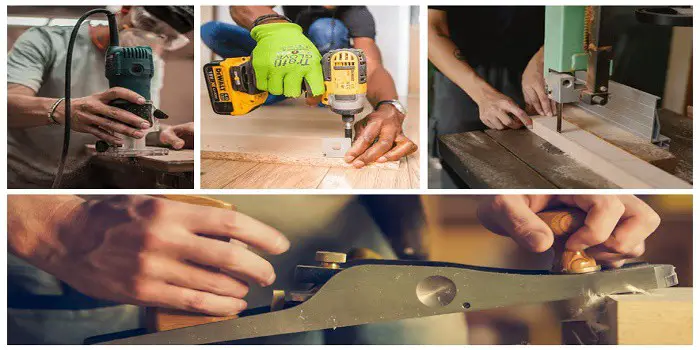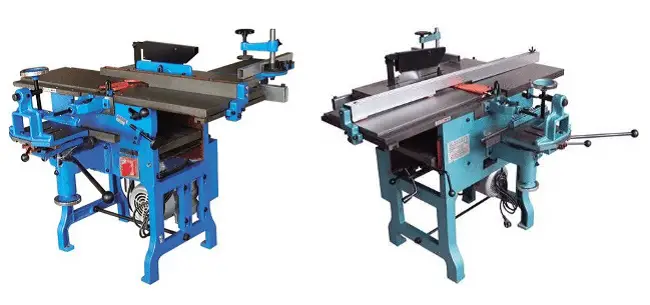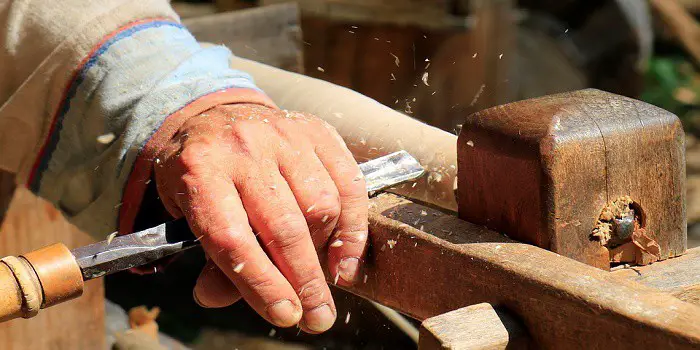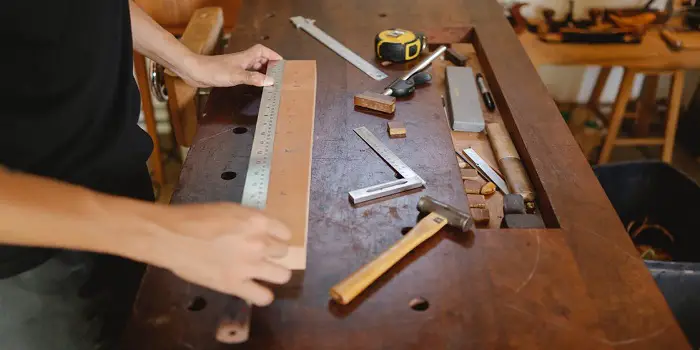
It’s possible to only use hand or manual tools when woodworking, but then it becomes a slower process.
For certain projects, a woodworking machine becomes essential for its fast completion.
The trick is to discover the type of machine that is best for your DIY project or shop.
Everything starts with the two basic types of woodworking devices – the first is the stationary machines, and the other one is handheld power tools.
Woodworking machinery should be used when it helps to complete a particular job faster and without losing quality.
In fact, some types of machines will perform better compared to hand tools.
For your work area, finding the right machine starts with your experience and workload.
Then, you should narrow down the choices to those that work best for the lowest price.
Handheld machines for woodworking
What follows is a list of the different types and names of woodworking machines available, starting with handheld power tools that are generally cheaper but commonly used.
1- Electric Drill
One of the most common and recognizable of all handheld tools, the electric drill consists of a motor on one end and a chuck on the other which holds the screws.
Electric drills may come with a cord to plug into the outlet, but today battery-powered versions are becoming more popular.
A good electric drill will have different driving speeds and hold a wide variety of bits.
2- Handheld Electric Plane
This works just like a manual plane, except it can smooth the wood at a faster rate with less energy.
You can adjust the machine as you like to get the type of depth desired.
The motor helps you achieve the results that are desired while not having to use as much elbow grease.
3- Jig Saw
When you need to cut curves into the wood, the jig saw is the perfect universal woodworking device.
The reciprocating blade means it moves up and down when driven by the motor.
This allows you to guide the jig saw over the flat surface of the wood and cut the shapes you want.
The ability to move in a variety of directions offers great versatility, but for straight cuts, you may want to use another type of saw or use a guide to keep the jig saw on the line.
4- Nail Gun
Sometimes called a nailer, the nail gun does the work of a hammer but faster.
You simply place the nail gun over the desired location and press the trigger.
This will power the nail into the wood quickly and easily.
The gun itself may use a spring-action, but more commonly, it will be powered by compressed air, propane, or butane, and some are even magnetically powered.
When you need to place a lot of nails quickly, the nail gun is an indispensable tool.
5- Router
This multipurpose device lets you hollow out sections of wood and other materials with ease.
It may look like a sander at first, thanks to the circular blade, but it does not smooth out the wood like a sanding device.
However, it is quite versatile, and there are different routers available for your needs.
6- Sanders
The handheld sander comes in different designs.
From the belt to orbital and even random orbit sanding machines, they can smooth the wood far faster compared to doing the job by hand.
The device itself consists of a motor that drives the belt or disc of sandpaper over the surface.
You can choose the grit level of the sandpaper for the job that is desired.
Stationary machines for woodworking
Handheld machines are quite versatile, and some are even powerful. But stationary machines have their place as well.
While larger and not portable, they offer more power and stability than their handheld counterparts.
What follows are some of the most common stationary machines used in woodworking.
7- Bandsaw
A device that is well over a century old, the bandsaw is a flexible saw-tooth blade that is really a band fitted over two spinning wheels.
An electric motor drives the wheels, and you push the wood into the blade as it passes down vertically.
Because of the thin blade, bandsaws are highly popular in workshops because you can get a precision cut.
Plus, the automated bandsaw will feed the material without human assistance. This allows one operator to oversee several automated bandsaws at once.
8- Jointer
To create a flat surface across a wooden board, a jointer is often used.
Sometimes called a flat top, buzzer, surface planer, or just plain planer, the jointer is designed to prep the edges of boards that are to be joined together, hence the name.
9- Lathe
This is a device in which the wood is secured and rotated at high speeds.
A wood lathe allows you to carve the outside of the wood to the shape you desire – like the legs of wooden tables are often shaped using a lathe.
The material is set into the lathe starting at the headstock. This holds the wood in place while the tailstock at the other end is connected to the motor.
As the wood spins, you can use a chisel against the surface to cut in shapes.
Once the desired shape is achieved, you can then use sandpaper over the spinning wood to smooth it out.
10- Table Saw
Perhaps the most recognizable of all stationary machines used for wood, the table saw is sometimes called a bench saw or sawbench because of its appearance.
An electric motor drives the circular blade.
You push the materials through the blade that is sitting inside the table but sticking up from the surface.
You can adjust your table saw for the height of the blade to get the cut that is desired.
It is the perfect device for rough cutting larger pieces of wood into smaller, more manageable sizes.
Just be sure to use a push stick or other device that keeps your hands away from the blade.

Combined multifunction machines for the woodworking industry
When talking about different woodworking devices, tools, and machines, it’s worth mentioning these varieties as well.
A “combination woodworking machinery” is a kind of machine that’s a combination of function and power of several machines in one single piece.
It’s usually designed for smaller shops due to its space-saving feature, making it convenient for woodworkers to work with only one smaller unit rather than dealing with several bigger machines.
For example, imagine if you need to work on a table saw and require to switch to a sharper between your job.
These multipurpose combined woodworking machines are found to be most useful in such a scenario.
Types
There are wide varieties of multipurpose woodworking machines, and you can find them with different names, such as 5-in-1, 8 in one, and even all-in-one combination woodworking machines.
There is also a universal combined machine which is a great option for small craftsmen and hobbyists who do not usually have larger workloads.
It comes equipped with all the classic processing tools, which allow them to work on a smaller level no matter what type of wood they want to work on (like solid wood, hardwood, softwood, MDF, chipboard, etc.).
It’s basically, based on the features and pricing, a multipurpose woodworking machine may combine several different machines, like a surface planer, thickness planer, jointer, table saw, moulder, mortiser, shaper, etc., into one single piece.
All you need is to reconfigure the machine and switch between different jobs without wasting any time.
Limitations
Combination woodworking machines do come with some disadvantages as well.
A few of these downsides include:
- They can be expensive
- Need proper skills for operating
- It can take time to switch from one function to another
The price of combination machines can vary significantly, which will generally depend on their size, quality, brand, and the functions included.
Obviously, the more function it has, the higher will be its cost and size.
Also, machines with five or more functions will be hard to upkeep, clean, and maintain.
So, IMO, woodworkers who do not need too many functions should generally go with single machinery or a cheaper machine with lesser functions.
You can also find some used models that are available for sale if you want a machine at a lower price.
When buying, check the reviews, and research carefully to check the warranty period and availability of replacement parts.
Also, keep in mind the space of your workshop so that you do not end up buying a heavy-duty larger machine that is difficult to accommodate and work with.
FAQs
What is the most versatile woodworking machine?
IMO, the table saw is the most versatile electric woodworking tool that you should essentially have.
It can make a wide variety of cuts, including rip, crosscut, miter, bevel, and rabbet.
With the right blade, a table saw can even make dado and molding cuts.
Plus, it’s relatively easy to use, provided you have some basic woodworking knowledge.
If you are really on a budget and can afford to buy one multipurpose machine, this is the one you should get first.
New vs. old machines for wood projects- what should I get?
This decision comes down to personal preference and what you feel most comfortable using.
That said, newer machines tend to offer more features and options than older ones. They may also be easier to use, thanks to advances in technology.
If you’re just starting in woodworking, it might be a good idea to opt for a newer machine. This will give you a chance to learn all the features and figure out which ones you like best.
If you’re more experienced, the older machine may suit you just fine. You may already know which features you need and prefer, so an older machine that doesn’t have all the bells and whistles may be just what you’re looking for.
No matter which type of woodworking machine you choose, be sure to read the manual before using it. This will help you understand how to use the machine properly and avoid accidents.
Where can I buy the used woodworking machines for sale online?
There are a few different places you can buy used woodworking machines for sale online.
eBay is a good option, as you can often find machines that are being sold by individuals.
Craigslist is another option, but you will need to be careful as there are often scams on this site.
Finally, Exapro.com is also a great website that specializes in selling used woodworking machinery along with many other tools in various different industries.
You can browse through the different machines they have for sale and contact the sellers directly.
When buying a used woodworking machine, be sure to inspect it thoroughly before making a purchase.
Check for any damage and make sure all the parts are included.
It’s also a good idea to ask the seller if they have a warranty or return policy in case there are any problems with the machine.
Final Thoughts
Understanding the different types of woodworking machines available will help you discover the right ones for the jobs you need to be accomplished.
Knowing what is needed will save you time and effort in getting the proper tools.
For small jobs, handheld power tools are a good start – they are inexpensive and quite effective at woodworking.
However, if you work with larger materials and need to make frequent cuts, then table saws and bandsaws are good places to start.
Stationary machines are more suited to frequent work, so you should consider them as well.
Share the post "10 Different Types of Woodworking Machines – With Uses"

Hi, I am Mark Garner a professional carpenter, woodworker, and DIY painter. I live in the small city of Peoria, Arizona as a semi-retired woodworker. I have started this blog with a simple motive to help you with my wood experience in this sector. If you like to know more about what I love doing and how it all got started, you can check more about me here.





